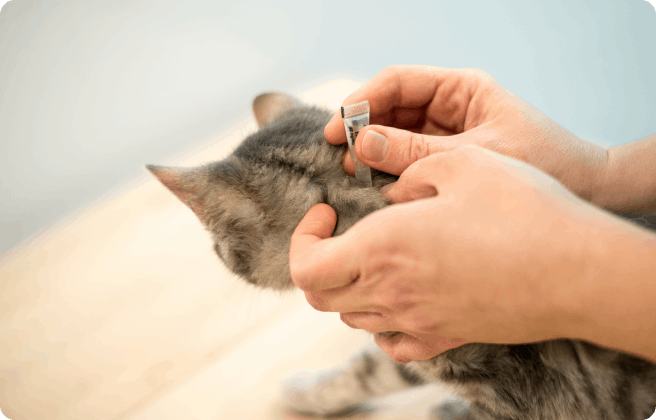
Fleas and ticks are a common problem for cats and your cat will probably experience these unwanted guests at least once in their lifetime. However, if not treated quickly they can be very unpleasant for your cat and cause complications such as anemia and flea borne diseases in both cats and humans.
What is a flea?
Fleas are tiny, wingless insects or parasites — roughly 0.1 to 0.32 cm (0.039 to 0.13 inches) in length — which live on the exterior of a host and feed exclusively on blood. They prefer to live and feed on animals but will bite people if they need to. Female fleas consume about 15 times their body weight every day to reproduce.
Cat fleas are different to dog fleas, but your cat can catch dog fleas and vice versa, as fleas have an 8-inch vertical jumping ability — almost 100 times their own body length. They can easily jump from the floor onto your pet. Fleas are transmitted from other animals, the garden, clothing, shoes, and your home.
Fleas have a lifecycle which makes them very tricky to avoid. They can either have a short life of around 14 days or survive for up to a year laying eggs and spreading daily. Female fleas can lay a huge amount of up to 50 eggs a day. Most fleas have four life stages: egg, larva (which burrows into upholstery), pupa (in a cocoon), and adult. It is when the pupae hatch that a flea will jump onto your cat.
There are over 2,500 species of flea, with more than 300 species living in the United States. However, only a few species can affect people’s health.
What is a tick?
Ticks are small insects or parasites — roughly 1mm – 1cm (0.34 – 0.4 inches) in length — which live on the exterior of a host and feed on blood. Like fleas, ticks prefer to live and feed on animals but will bite people if they need to. They are slow feeders and can be attached to the host for between 3-6 days.
Cats are less likely to get ticks than dogs, but it is possible. Ticks are active throughout the year but are most common between Spring and Autumn. They can be found in woodland, grassland, and leaves. Essentially anywhere they can latch onto where animals or potential hosts might walk past. This includes overgrown backyards, woodpiles, and even bird feeders.
Unlike fleas, they do not jump, but wait for an animal or human to pass by before climbing on.
Ticks have a similar life cycle to fleas; egg, larva, nymph and adult. But it can take them up to 3 years to complete a full lifecycle, and some will die if they can’t find a host to feed on. Ticks have to feed at each of the life cycle in order to grow and move onto the next one. Females can lay anything up to 6,000 eggs.
In the United States, two families of ticks can be found — Ixodidae (hard ticks) and Argasidae (soft ticks). Different states have recorded different species and therefore different diseases, such as the Rocky Mountain wood tick which is found in Rocky Mountain states and responsible for transmitting Colorado tick fever, tularemia, and Colorado tick fever. However, although there are hundreds of tick species, less than a hundred species can affect people’s health.
How to look for fleas
Fleas are reddish-brown in color with flat bodies but are very hard to spot. The tell-tale sign of fleas is actually ‘flea dirt’ — excreted blood which has been partially digested by fleas. This is also what flea larvae feed on.
And, of course, your cat will be scratching excessively.
Fleas prefer warmer and more humid weather so be vigilant at these times, but they can survive all year as long as they are able to feed.
How to look for ticks
Ticks are dark brown with flat bodies but when they have fed their bodies swell to a more circular shape and their bodies turn more gray. They are bigger than fleas but still hard to spot. When they have fed they are easier to find, so run your hands along your cat’s fur and skin to feel for any small bumps which may be ticks.
You can differentiate ticks to skin tags or lumps by their eight legs, as they are related to spiders.
What health issues can fleas and ticks cause?
Fleas and ticks carry several diseases and germs which are transmitted to their host when they bite and create an open wound. Infected flea feces, or flea dirt, can be scratched into the open wound, or the disease can be transmitted through the process of feeding.
The diseases which are carried by ticks will vary from state to state, with some being more prevalent than others.
Even if your cat does not become infected with a disease, fleas and ticks are very unpleasant. Some of the diseases and symptoms which fleas and ticks can cause are listed below.
In cats:
- Persistent itching
- Hair loss and bald patches
- Sores and scabs on the skin
- Loss of blood or anemia
- Tapeworm
- Flea allergy dermatitis
- Lyme Disease
In humans:
- Flu-like symptoms
- Pink or red rash
- Fever
- Allergic reaction
- Swollen lymph nodes
- Lyme disease
- Plague
- Flea-borne typhus
- Cat scratch disease
- Tapeworm
- Anaplasmosis
- Babesiosis
- Borrelia Miyamotoi
- Colorado Tick Fever
- Ehrlichiosis
- Heartland virus
Most of the above symptoms and diseases can be treated, but if not treated immediately, can cause longer health complications.
Children are at a higher risk from ticks because they spend more time closer to the floor and outdoors.
How to prevent fleas and ticks on my cat
Fleas and ticks can be incredibly unpleasant, and potentially dangerous, for both cats and humans.
The best way to prevent fleas and ticks on your cat is to build flea treatment and tick prevention into your cat’s regular care routine. You can prevent fleas and ticks by:
Regular treatment
Keep up with treatment throughout the year to deal with all stages of the flea and tick life cycle — killing adults and preventing eggs from hatching.
There is a huge range of flea and tick prevention products available to buy, such as spot-on treatment, oral medication, shampoos, tick dips, tick collars, powders, and even sprays. Although you should always consult your veterinarian before treating your cat. Some products may not be suitable for your cat and could cause further health complications. Always follow product instructions.
Regular grooming
Bathe and brush pets regularly, with preventative shampoo if possible. This can not only help you to spot any lurking pests, but can prevent matting and potential hiding spots for fleas.
Keep on top of housework
Fleas love to hide in your home and can survive without a host for months. It’s easier to keep on top of the cleaning than it is to get rid of fleas once they’re inside, so sweep or vacuum regularly. This includes carpets, rugs, and sofas. Make sure you empty the vacuum after you’ve finished. You should also wash bedding, especially pet bedding, regularly.
Limiting time outdoors
Ticks live in backyards, woodland, and grassy areas, so limiting time outdoors could prevent ticks from latching onto your cat. It can also mean less contact with animals who may already have fleas.
Limit contact with wild or stray animals
Wild or stray animals will not have considerate pet parents who are keeping them up to date with their flea and tick treatment. They will mostly be carrying fleas and/or ticks which can easily be passed onto your cat. Avoid leaving cat food outside as this could encourage stray animals to hang around your house and therefore prevent an infestation.
Reduce flea and tick habitat in your yard
Fleas prefer to be in the shade as they can’t tolerate long periods in the sun, and ticks can choose from a whole range of backyard habitats to live in. Try to make your yard an undesirable place to be for these pests by mowing frequently, raking thoroughly, removing firewood, rock piles and debris from outside your house. Also make sure you keep the lids tight on any compost or trash cans which are kept outdoors, and seal any holes where rodents can enter, as rodents commonly carry fleas and ticks.
Check your cat daily
A quick visual scan of your cat’s skin and fur should be enough to spot fleas, but you will need to run your fingers along your cat’s body to feel for ticks. Be especially vigilant after your cat has spent time outdoors or in areas which you think, or know, fleas may have been active.
Immediate treatment
If you find a tick on your cat, remove it immediately and seek advice from your veterinarian. If you find fleas on your cat, you can immediately bath them and use a flea comb, but you should also ask your vet for advice as well. Dealing with fleas and ticks straight away can avoid further infestation.
How to get rid of a flea or tick infestation
If the prevention stages haven’t worked or your cat already has fleas or ticks as you’re reading this, it’s time for treatment.
How to remove fleas
Roughly 95% of flea eggs and larvae actually live in the environment rather than on your pet, so most of the work is going to be washing upholstery, bedding, and clothes. Getting rid of fleas is a long and difficult process as the flea’s life cycle means they could keep appearing in your home for months to come — if eggs and larvae are not removed effectively.
To eliminate fleas, follow these steps:
Deep clean your house
Thoroughly vacuum all fabrics including rugs, carpet, and sofas. Wash human and pet bedding.
Treat, bathe, and comb all pets
Soap is a gentle insecticide which kills adult fleas, but you could also use a specialist treatment shampoo, if recommended by your vet. Use a flea comb and look carefully around the face and neck area. Your vet will also recommend a flea or tick treatment product.
Treat your home
Just like your cat, your house can be treated for fleas. Start treatment at the same time as pet treatment to disrupt the flea life cycle. A licensed pest control service can help you to choose which products to use in your home.
Repeat!
At some stages of the flea life cycle, they are resistant to insecticides and other treatment products. To eliminate all fleas in every stage of the cycle, you’ll need at least two follow-up treatments after the first. This should be within 5-10 days after the first treatment. Your vacuum and washing routine should be continued at the same time to remove all remaining eggs, larvae and young fleas.
How to remove ticks
If you find a tick attached to your cat, remove it as soon as you can with these steps:
- Use a clean pair of tweezers, or a commercial tick-removal product, to grab the tick as close to the skin as possible.
- Pull upwards with a steady pressure without twisting or jerking the tick.
- If you twisted by mistake, the mouth-parts of the tick could have broken off and may still be in the skin.
- Remove the mouth-parts with tweezers or if you’re unable to, leave it alone.
- Thoroughly clean the bite area and your hands after removing the tick with soap and water or rubbing alcohol.
- To kill or dispose of the tick, put it in alcohol, place it in a sealed bag or container, flush it down the toilet, or wrap tightly in tape.
- If you or your pet develop symptoms after removing the tick — even if it’s after a few weeks — seek advice from a veterinarian or doctor.
We uphold the highest editorial standards when creating the authoritative content pet parents rely on and trust.
Every piece of clinical content on the Cat Food Advisor is reviewed by our certified Veterinary Advisory Board, which consists of licensed veterinarians and medically certified specialists.
Our reviews are completely independent; we are not paid by any pet food company to promote their products favorably. We do not accept money, gifts, samples or other incentives in exchange for special consideration. For more information see our Disclaimer & Disclosure page.










